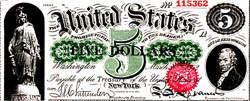3 May, 2007 – I came across a very interesting story yesterday that seemed to attract little attention among the mainstream media. This, out of Washington today:
WASHINGTON, May 2 (Reuters) — “The U.S. Treasury on Wednesday said it will end issues of three-year notes after reduced debt refunding auctions next week in response to strong tax receipts and an improving federal budget picture.”
This story is truly noteworthy in my humble estimation for two reasons. (1) The implications and ulterior motives of such a move are truly worth evaluating; and (2) The spin placed upon this move by the government is even more interesting.
 To begin, anyone that has seriously investigated the federal budget instead of just unquestioningly digesting the soundbites the government feed us would find the explanation of discontinuation of 3-year notes due to an “improving federal budget picture” 100% non-credible as the true instigator of this action. What is even more interesting is the fact that of 10 different sources that reported this action from different cities around the world, there was not one that challenged the spin that an “improving federal budget picture” was indeed the reason for this action.
To begin, anyone that has seriously investigated the federal budget instead of just unquestioningly digesting the soundbites the government feed us would find the explanation of discontinuation of 3-year notes due to an “improving federal budget picture” 100% non-credible as the true instigator of this action. What is even more interesting is the fact that of 10 different sources that reported this action from different cities around the world, there was not one that challenged the spin that an “improving federal budget picture” was indeed the reason for this action.
As part of this plan, the U.S. Treasury will refund $32 billion of 3-year notes as well as 10-year notes and 30-year bonds. “Discontinuing the three-year note will allow Treasury to ensure large liquid benchmark issuances, better balance its portfolio, and manage the improving fiscal outlook,” Treasury Assistant Secretary for Financial Markets Anthony Ryan said in a statement.
I think the key point is to “better balance its portfolio.” While buyers of Treasury notes can still purchase 2-year notes and bills with maturities of less than a year if they want short-term exposure to Treasury notes, the fact is that the 3-year note was an enormous market that no longer exists. The further refunding of 10-year notes and 30-year bonds in addition to the future auction of 30-year bonds being $1 billion less than expected simply points to the fact that the U.S. government has decided its time to decrease their own exposure to the U.S. dollar as well and to push this weakening currency back onto its naïve purchasers.
Sure, there will be those that argue that my argument above doesn’t make sense because it behooves the government to hold on to debt denominated in a weakening currency as it makes their debt cheaper as they actually pay back the lenders (in essence the bond buyers) with cheaper money. I’ve heard this argument many times but I’m not buying it. Why? If they feel as though they can diversify out of the dollar and purchase assets that will appreciate at multiples the rate at which the dollar will continue to decline then it absolutely MAKES SENSE to pay off debt early and push more of a terrible currency back on to your lenders.
However, I know that there is still a large contingency of people out there that believe everything they read in the papers and take the word of the government as the truth. I know that this is precisely the reason why, when I told a number of people with businesses overseas with large exposures to the U.S. dollar that they needed to hedge their exposure with swaps, collars, futures, basically any derivative product that would protect them against a falling dollar, a number of people actually told me flat out that I was wrong, and that according to “government economic reports”, the dollar would strengthen. While there was a very small handful of those businessmen that were open-minded and agreed with me, I was amazed at those that vehemently disagreed with me. I was not amazed that they vehemently disagreed with me, but that the whole foundation of their opposition viewpoint was based upon “government economic reports”. Well, to the contingency of people that keep believing the government sound bites, all I can say is, Goodnight & Good Luck.
Though the U.S. dollar seems overdue for a bounce to the upside presently, the long term outlook still remains dismal.
[tags]dollar crisis, death of 3-year U.S. treasury notes[/tags]
__________________
J.S. Kim is the founder and Managing Director of maalamalama, a comprehensive online investment course that uses novel, proprietary advanced wealth planning techniques and the long tail of investing to identify low-risk, high-reward investment opportunities that seek to yield 25% or greater annual returns.